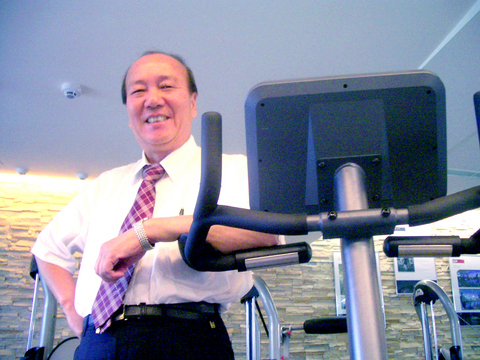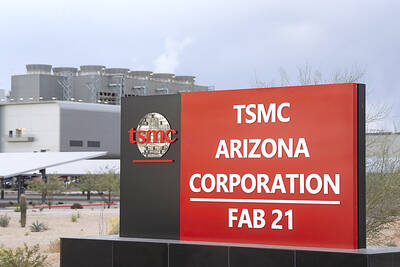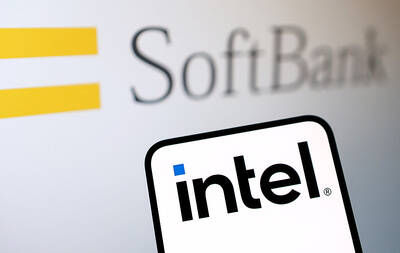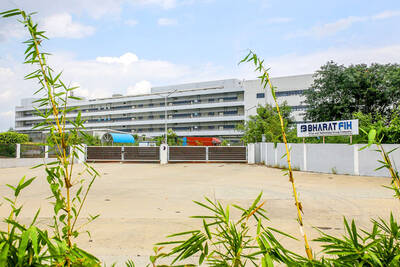Thirty-one years ago, when then 34-year-old Peter Lo (羅崑泉) accepted his first order to produce barbells for US-based client Ivanko, he could have hardly thought that it would later pave the way for a world-class fitness equipment empire.
It was a US$400 order for 400 pieces of barbells, and the company demanded Lo charge only NT$15 (US$0.50) per kilogram, half of the price in the US.
The order did not come very easily.

PHOTO: JASON TAN, TAIPEI TIMES
He and his wife had handwritten letters to more than 1,000 US companies, inviting them to work together in any form of business.
Lo, who was born to a poor farming family and sold fluorescent lamps on the side of the street in earlier days, had no idea what a barbell was, but he jumped at the chance because it was his first business opportunity in six months after quitting his two-year job with customs.
"I didn't have anything at that time but a body full of energy, which was my biggest capital," said Lo during a media tour on Aug. 22.
In that year, Lo established Johnson Metal Industry (
The company's name was later changed to Johnson Health Tech Co (JHT,
The partnership with Ivanko made JHT the world's largest barbell original equipment manufacturer in three years.
The early days of JHT were not a bed of roses. Lo only had his wife and a partner on board and started everything from scratch, but the desire to leave behind his cash-strapped plight saw him gradually expand the business.
He began recruiting research and development (R&D) staff in 1980 to design cardiovascular fitness products for leading brands such as Ross, Universal, Tunturi and Schwinn.
After carrying out original design manufacturing for another 15 years, Lo realized that the time was ripe to venture into the own-brand business to take the company, of which he is chairman, onto the world stage.
This ambition gave birth to the company's first brand, Vision Fitness, in 1996, with North America the first target market for fitness equipment.
Three years after that, the brand Horizon Fitness was launched for the home user market, and "Matrix Fitness" followed two years after that for the commercial market, including fitness companies, clubs, hotels and corporations.
With a solid foundation in North America, JHT planned to replicate its success in Taiwan in 2003 by opening retail stores to sell Johnson-branded equipment.
The company was listed in Taiwan the same year.
"North America is the largest fitness market; it adopted the fitness concept very early. The Asian markets, especially China and Southeast Asia, have been gaining momentum in recent years," Lo said.
The global fitness equipment industry is valued at US$6 billion a year, with North America accounting for US$4 billion of that figure and growing at 4 percent a year, according to William Poon (潘炳志), JHT's sales and marketing manager.
Other regions, including Asia, are expected to grow at 7 percent a year, he said.
With aggressive expansion, JHT has become the world's No. 5 fitness equipment firm, behind major US rivals Icon Health & Fitness Inc, Nautilus Inc, Life Fitness and Precor Inc.
Over the past five years, JHT has been seeing in excess of 30 percent revenue growth annually. It has become an empire of 21 global subsidiaries, two factories and more than 6,500 staff.
In Asia, it has 45 outlets in Taiwan, 80 in China, 102 in Thailand and 11 in Malaysia.
Last year, JHT raked in sales of US$267 million, a rise of 32.8 percent from a year ago.
The figure was the highest among the top-five firms, with No. 4 Precor seeing 20.3 percent growth, and No. 1 Icon reporting a decline of 5.3 percent.
For the first half of the year, JHT's sales hit US$127 million -- amounting to annual growth of 15.2 percent -- and saw a 20 percent increase in after-tax net profit at US$15 million.
Last month, the company sealed new deals totaling US$42 million to supply equipment to the largest department-store company in the US, Sears Holdings Corp, as well as to Canadian Tire Corp, Canada's largest auto parts and household goods retailer.
JHT is poised to overtake Icon to become the world's leader in the fitness equipment industry by 2008, Lo said.
With this ambitious goal in mind, the company will be opening a second Chinese factory in November.
Spanning around 150,000m2, the plant is the result of a US$20 million investment to produce strength machines, such as plate loads and free weights.
Lo is busy catching up to his company's global peers, but he has also laid out plans for JHT after 2010.
He has gathered a team of staff to study potential opportunities relating to health, especially health supplements, which will take the firm's business to new heights.
"To enjoy a long life, we need to live healthily by exercising and eating healthy food," he said.
"Fitness is my long-term job. I am not only working for the sake of money, but also calling out to others for a healthy lifestyle," he added.

Taiwan Semiconductor Manufacturing Co (TSMC, 台積電), the world’s biggest contract chipmaker, booked its first-ever profit from its Arizona subsidiary in the first half of this year, four years after operations began, a company financial statement showed. Wholly owned by TSMC, the Arizona unit contributed NT$4.52 billion (US$150.1 million) in net profit, compared with a loss of NT$4.34 billion a year earlier, the statement showed. The company attributed the turnaround to strong market demand and high factory utilization. The Arizona unit counts Apple Inc, Nvidia Corp and Advanced Micro Devices Inc among its major customers. The firm’s first fab in Arizona began high-volume production

VOTE OF CONFIDENCE: The Japanese company is adding Intel to an investment portfolio that includes artificial intelligence linchpins Nvidia Corp and TSMC Softbank Group Corp agreed to buy US$2 billion of Intel Corp stock, a surprise deal to shore up a struggling US name while boosting its own chip ambitions. The Japanese company, which is adding Intel to an investment portfolio that includes artificial intelligence (AI) linchpins Nvidia Corp and Taiwan Semiconductor Manufacturing Co (TSMC, 台積電), is to pay US$23 a share — a small discount to Intel’s last close. Shares of the US chipmaker, which would issue new stock to Softbank, surged more than 5 percent in after-hours trading. Softbank’s stock fell as much as 5.4 percent on Tuesday in Tokyo, its

The prices of gasoline and diesel at domestic fuel stations are to rise NT$0.1 and NT$0.4 per liter this week respectively, after international crude oil prices rose last week, CPC Corp, Taiwan (台灣中油) and Formosa Petrochemical Corp (台塑石化) announced yesterday. Effective today, gasoline prices at CPC and Formosa stations are to rise to NT$27.3, NT$28.8 and NT$30.8 per liter for 92, 95 and 98-octane unleaded gasoline respectively, the companies said in separate statements. The price of premium diesel is to rise to NT$26.2 per liter at CPC stations and NT$26 at Formosa pumps, they said. The announcements came after international crude oil prices

SETBACK: Apple’s India iPhone push has been disrupted after Foxconn recalled hundreds of Chinese engineers, amid Beijing’s attempts to curb tech transfers Apple Inc assembly partner Hon Hai Precision Industry Co (鴻海精密), also known internationally as Foxconn Technology Group (富士康科技集團), has recalled about 300 Chinese engineers from a factory in India, the latest setback for the iPhone maker’s push to rapidly expand in the country. The extraction of Chinese workers from the factory of Yuzhan Technology (India) Private Ltd, a Hon Hai component unit, in southern Tamil Nadu state, is the second such move in a few months. The company has started flying in Taiwanese engineers to replace staff leaving, people familiar with the matter said, asking not to be named, as the